Home
Eichberg
(Eltville) (Landesheilanstalt Eichberg)
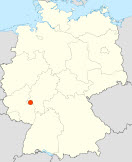
The Kinderfachabteilung at the Eichberg clinic (asylum), situated close to
the town of Eltville, was the first of two to be established in what today
is the state of Hesse. It operated from March or early April 1941 until
March 1945. The director of the clinic was Dr. Friedrich Mennecke (who was
also an evaluator for "T4"), and responsible for the Kinderfachabteilung was
Dr. Walter Schmidt, who was also the clinic's deputy director. Dr. Mennecke
was commissioned for the German army at the end of 1942 due to a conflict
with Otto Friedrich ("Fritz") Bernotat, the commissioner for the state
hospitals in Hessen-Nassau, and thereafter was director only on a nominal
basis, while Dr. Schmidt carried on as de facto director.
The Eichberg trial in Frankfurt in December 1946 was the second "euthanasia"
trial under the jurisdiction of German courts (after the conviction of Dr.
Hilde Wernicke and nurse H. Wieczorek in Berlin for their involvement in
crimes at Meseritz-Obrawalde in March 1946), in an effort to hold the
perpetrators accountable for about 2,300 patients who had died at the
Eichberg as a result of the murderous policies, and as many who had been
sent to die in the gas chamber at Hadamar. The trial included a judicial
review of the murders in the children's ward, and henceforth all subsequent
publications that mentioned "children's euthanasia" listed the Eichberg as
one of those facilities where such murders had taken place and where beyond
speculation. It figured quite prominently, for example, in Alice
Platen-Hallermund's Die
Tötung Geisteskranker in Deutschland (1948).
For his role in filling out for T4, his role as medical
evaluator for this organization, his involvement of the transfer of patients
to the murder facility Hadamar, the establishment and operation of a special
children's ward, and finally the murder of adult patients, Dr. Mennecke was
sentenced to death and died in 1947 before the verdict could be carried out,
to tuberculosis or possibly to suicide. Dr. Schmidt confessed to have killed
between 30-40 children personally, and head nurse Helene Schürg between
30-40 on her part. The nurse also stated that about 500 children had been
admitted to the special children's ward, of whom 200 had been actively
killed. The station nurse Andreas Senft also confessed to killings. Dr.
Schmidt was initially sentenced to life, which in an appeals process was
changed to the death sentence, only to be commuted back to a life sentence
in 1949. A further pardon resulted in the reduction of the sentence in 1951
to 10 years, and after a public campaign in which hundreds of citizens from
the area and newspaper stories and editorials petitioned for his release, he
was released in 1953 and, in spite of having his medical license revoked,
practiced illegally in the Hattenheim area. The two nurses received prison
sentences of eight and four year, respectively, and received an early
release in 1951 and 1959.
The number of victims is estimated to have been at least 430 victims (Dickel
1991: 105). More than 500 children and youths died during the operation of
the Kinderfachabteilung - the vast majority of them was likely murdered
(Sandner 2003: 539).
To house the Kinderfachabteilung, an existing facility was recommissioned as
a children's barrack. It housed the younger children, while children older
than nine years of age were placed among adult patients in other stations.
The facility no longer exists.
: Dickel 1988, p. 19.
The Eichberg was also a place where other physicians of "children's
euthanasia" could be "instructed," such as was the case with Dr. M. Schütte of the Kinderfachabteilung Stuttgart in 1943 (see
Kinderfachabteilung Stuttgart; Sandner 2003: 536).
Dr. Schmidt's public support may in part be explained as a reaction and
defense mechanism against the negative publicity the Eichberg received
through the trial and its exposure in publications such as
Platen-Hallermund's. The facility had a poor reputation in the aftermath of
the trial (see Faulstich, in Vanja et al. 1999: 252-53), and although in
1949 on occasion of the hospital's 100th anniversary the director of the
Eichberg and the commissioner for the state hospitals still commemorated the
victims (Faulstich, in Vanja et al. 1999: 256), the memory of "euthanasia
crimes" slipped into oblivion. The director Dr. Gerhard Amler wrote an
unpublished ms. chronicling the history of the Eichberg facility in circa
1981, in which he referred to "children's euthanasia" and noted that a
total of 707 children had been admitted, of whom 499 died, buit when in
1982-83 a group of students and their teacher Dr. Horst Dickel began to
reinvestigate the events during the Nazi period, they found that the
director of the facility had not even heard of the trial (Dickel 1983: 4). A
similar amnesia was apparent among the older residents of towns and villages
around the Eichberg, among whom the students did not find a single one who
said to have had knowledge about the killing of children in the Nazi period,
and many were bothered about being asked about the past at all (Dickel 1983:
60-62). Yet according to the historian Markus Kreitmair (2000: 123), the
children's arrival at the train station in Hattenheim could hardly have gone
unnoticed, and surely the word must have spread quickly in this rural area.
As he notes, "even those who had not directly witnessed events were able to
use their common sense in arriving at the conclusion that children were
being killed at Eichberg. Evidence of this common knowledge can be seen in
villagers' warnings to parents that the Eichberg's children were used for
medical research" (p. 124). Such medical research was actually carried out
in conjunction with the Heidelberg University's Psychiatric Clinic under
Professor Carl Schneider, where children were examined, then send to
Eichberg to be murdered with the intention of having their brains returned
to Heidelberg for research (see Hohendorf et al. in Vanja et al. 1999;
Sandner 2003: 546-51; see also Kinderfachabteilung Wiesloch).
The inquiries of Dr. Dickel and his students marked a new period of interest
among scholars in the Eichberg during the Nazi period, and in the special
children's ward there in specific. A series of analyses followed (Dickel
1988, 1991; Orth 1989; Schneider-Wendling 1997; Sandner 2003), including a
first detailed analysis of the extant patient records (Teich/Tucholski
1992), which got its start when the memorial site Hadamar sought to include
information about children at Eichberg for its permanent exhibit
"Transferred to Hadamar" (1991) and covered the topic in its traveling
exhibit "'Euthanasia' in Hadamar: The National Socialist Politics of
Extermination in Facilities in Hesse," which expressly covers the murder of
children at Eichberg as one of its topics (see here).
On the premises, a memorial cross was erected in the cemetery in 1985 of the
clinic. The text inscribed in a plaque at the bottom reads as follows: "In
memory of the helpless human beings who fell victim to the
'euthanasia'-crimes of Nazis at the clinic Eichberg. Mostly their names are
not known. The death of these innocents persons must be a warning to us." In
1988 a display was attached to the chapel. It reads: "In memory of the
helpless children who fell victim to the 'euthanasia'-crimes at the Eichberg
during the time of National Socialism and lie buried here. Their death must
be a warning to us."
Source: Landeswohlfahrtsverband Hessen 1985: 79-80.
In the context of the decision to rededicate the chapel
that is surrounded by the old cemetery (on which victims of “euthanasia”
were buried) as a place of religious service around 1988, at which time
the commemorative plaque was placed on the chapel’s outside wall, and in
response to considerations to de-sanctify the cemetery, a commemorative
stone in the form of a sarcophagus was placed next to the chapel in the
old cemetery in 1993 (it was dedicated on July 2, 1993). Created by the
sculptor Uwe Kunze, it has the inscription "In memory of the many people who at the Eichberg fell victim to Nationalist
Socialist compulsory sterilization and "euthanasia" crimes; we
commemorate - the 301 women and men who were compulsorily
sterilized between 1935 and 1939; - the 2,019 patients, who in 1940/41
were transferred from the transfer facility to the killing center
Hadamar, among whom were 660 patients of the Eichberg; -
the 476 children with disabilities,
who between 1941 and 1945 in a so-called special children's ward
were observed "for scientific purposes" and then murdered; - the many male and female patients who between
1942 and 1945 were killed through exposing them to malnutrition and the
provision of overdosed medications. Their lives and deaths are a warning
to us, and an obligation for the presence and future." (In
Erinnerung an die vielen Menschen, die auf dem Eichberg Opfer der
NS-Zwangssterilisation und »Euthanasie«-Verbrechen wurden, gedenken wir –
der 301 Frauen und Männer, die von 1935–1939 unter Zwang sterilisiert worden
sind, – der 2019 Patientinnen und Patienten, die 1940/41 über die
»Sammelanstalt« Eichberg in die Tötungsanstalt Hadamar verlegt wurden,
darunter 660 Menschen vom Eichberg, – der 476 behinderten Kinder, die von
1941–1945 in einer sogenannten Kinderfachabteilung zu »wissenschaftlichen
Zwecken« beobachtet und dann ermordet wurden, – der vielen Patientinnen und
Patienten, die von 1942–1945 durch Unterernährung und überdosierte
Medikamente gewaltsam zu Tode kamen. Ihr Leben und Tod sind uns Mahnung und
Auftrag für Gegenwart und Zukunft.)
A teddy bear and wooden horse protrude from the
sculpture but seem to be slowly
sinking into it. This spatial
arrangement is meant to represent a process of falling into oblivion,
of the children themselves and the childhood of so many destroyed
on the Eichberg.
The memorial stone is located adjacent to a field that served as a mass
grave to the children. A field of roses under the custodianship of local
high school students was once placed there in 1988.
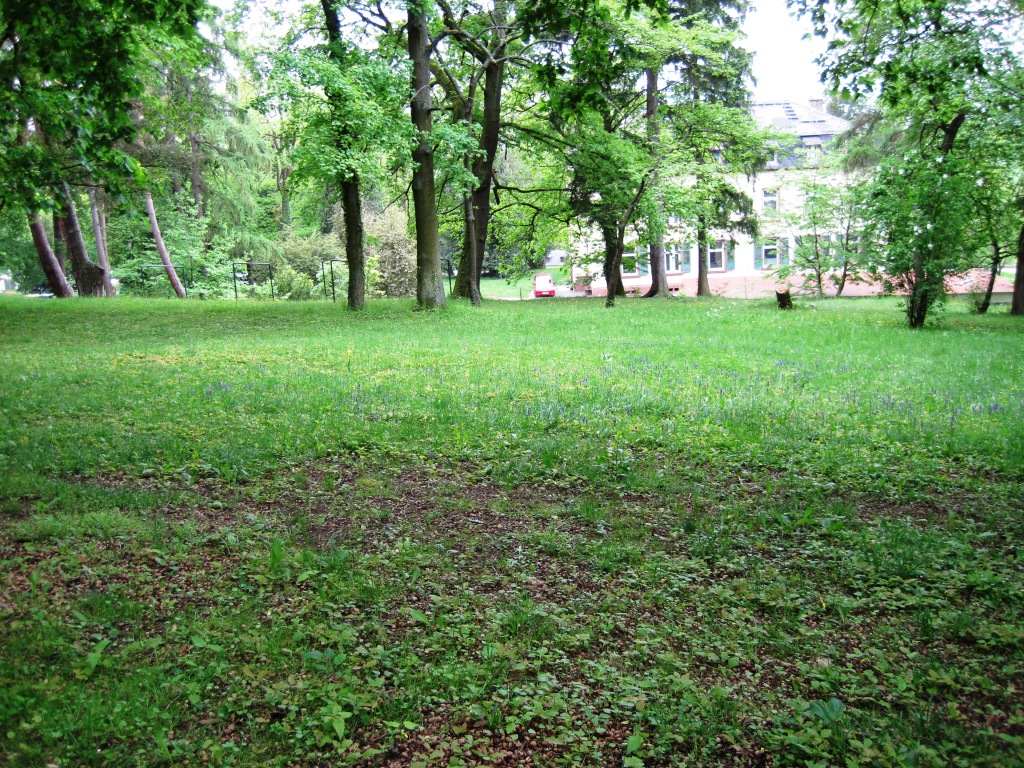
Source:
http://www.dekanat-badschwalbach.de/index.php?s_id=54&lang=de&rdl=123&r=1264772811&DKS=714d7b74fa46cfcb6a79403527366e08;
author
The Eichberg is one of a few places where a monument exists that expressly
alludes to the existence of a Kinderfachabteilung and its victims. Until
2010 the clinic's
web site did not address its past experience with "euthanasia" crimes
on the premises at all, and nor did the website of the
Landeswohlfahrtsverband (state social services association), which otherwise
provides an extensive documentation of commemoration at places of
"euthanasia" crimes. The website of the Vitos Rheingau now has a chronicle
on its website for Eichberg, which includes a brief reference to the
historical events 1933-1945 (here) and a link to a page that provides brief
information about the memorial (here).
Indications exist that many people in the region do not wish to go back to
this part of their history. At least this has been the impression of an
Eichberg historian who has lived in this area (M. Kreitmair, personal
communication), and is consistent with the experience of a regional
journalist. For when the latter published a series of articles on the
hospital at Eichberg in the regional newspaper Wiesbadener
Tageblatt, the response was very different from that to other
regional historical reports - there wasn't one at all (Schreeb 2006; and
personal communication).
There have been religious services
on Totensonntag ("Sunday of the Dead," observed on the last
Sunday before Advent) ever since the re-dedication of the chapel as a
site of religious service and the establishment of a memorial stone, but
few regular commemorative event outside religious contexts took place
until recently. On occasion of the 60th anniversary of the end
of World War II in 2005 students of a local high school studied the
history of the psychiatric facility Eichberg and participated in a walk to
the memorial. A commemorative memorial hour (Gedenkstunde) was observed on
1 September 2011 and is planned to be continued on that day annually from
now on.
On the occasion of the 150th anniversary of the
foundation of the hospital, in 1999 an exhibit entitled "Knowledge and
Error: The History of Psychiatry over Two Centuries: Eberbach and
Eichberg" was created, and a book was published to accompany it (Vanja et
al. 1999). In the aftermath of the exhibit
Protestant reverends of the clinic have begun to offer a tour for
interested visitors, and now twice a year, for clinic personnel. A
document about the tour can be found here. The reverends also work
with students on the topic of “euthanasia” crimes at Eichberg in the
context of ethical-religious education in schools.
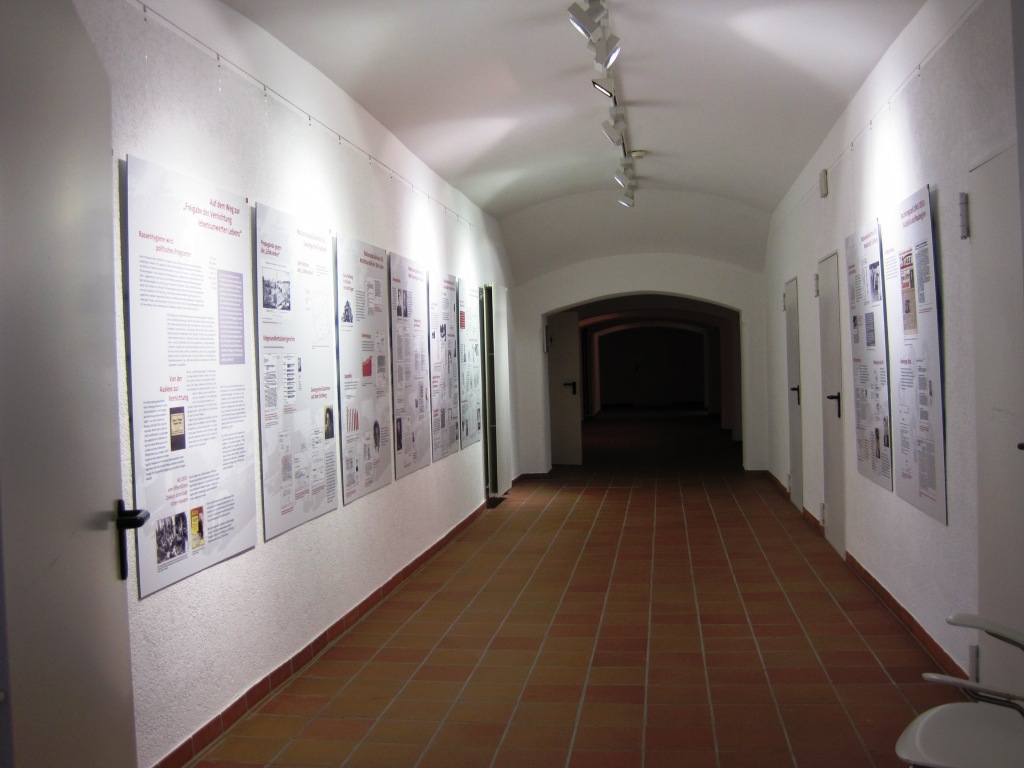
|
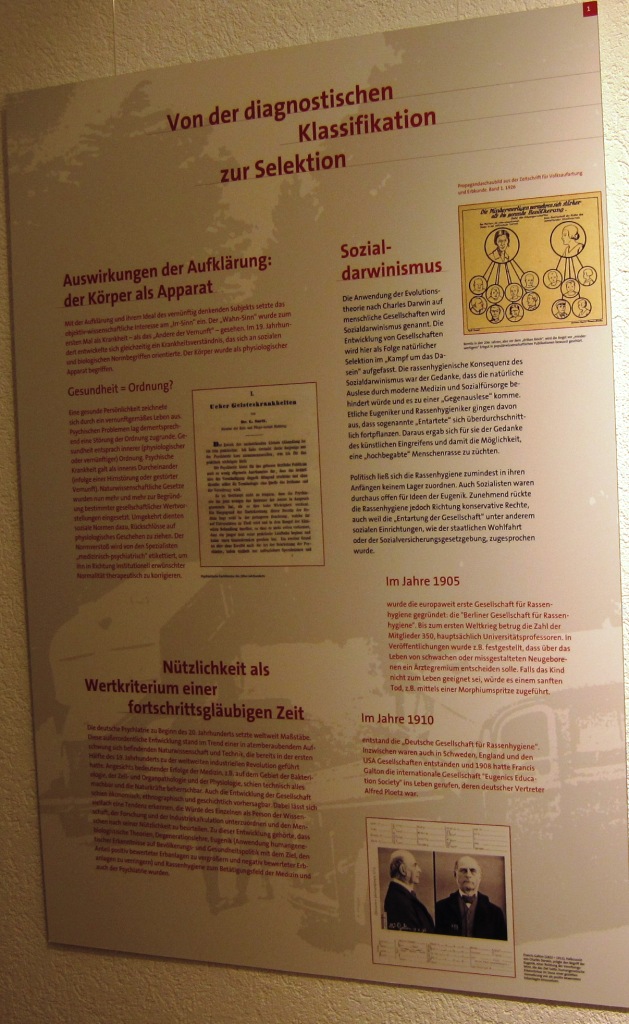
|
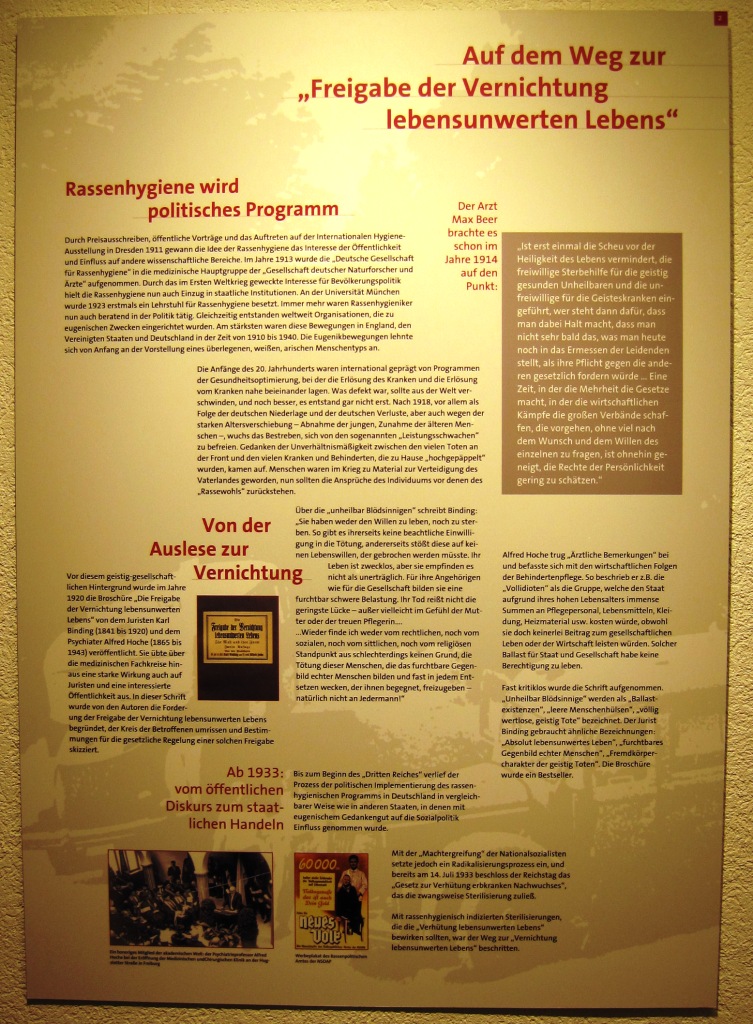
|
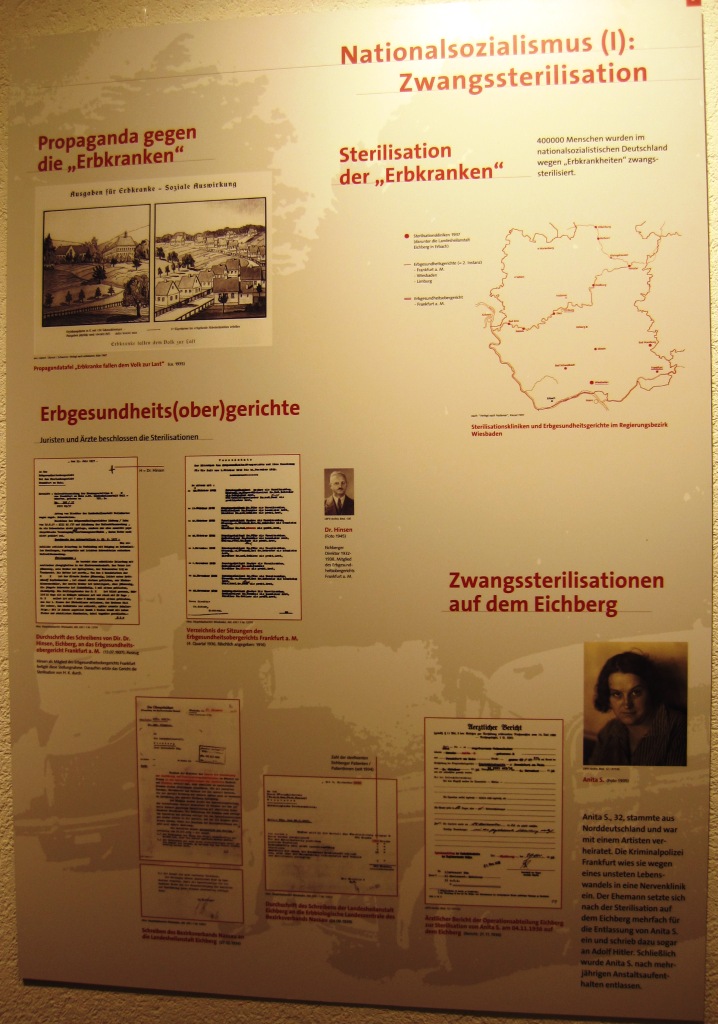
|
Panel 1: "From diagnostic
classification to selection"
Presents information about the development of ideas: notions of
mental illness in the aftermath of the Enlightenment, the value of a
person judged by the criterion of "usefulness"; social Darwinism;
and "racial hygiene." |
Panel 2: "On the road to 'Allowing
the annihilation of life not worth living'"
Discusses how "racial hygiene" becomes a political program: the
theses and impact of the book by Binding/Hoche, international
eugenics, and the passing of Germany's compulsory sterilization act
in 1933 as a first step toward the annihilation of the sick and
disabled.
|
Panel 3: "National Socialism (I):
Compulsory sterilization"
Presents propaganda material against the "hereditarily sick" and the
operation of hereditary health courts in the Frankfurt and Wiesbaden
areas, as well as the case of a Eichberg patient who was sterilized.
|
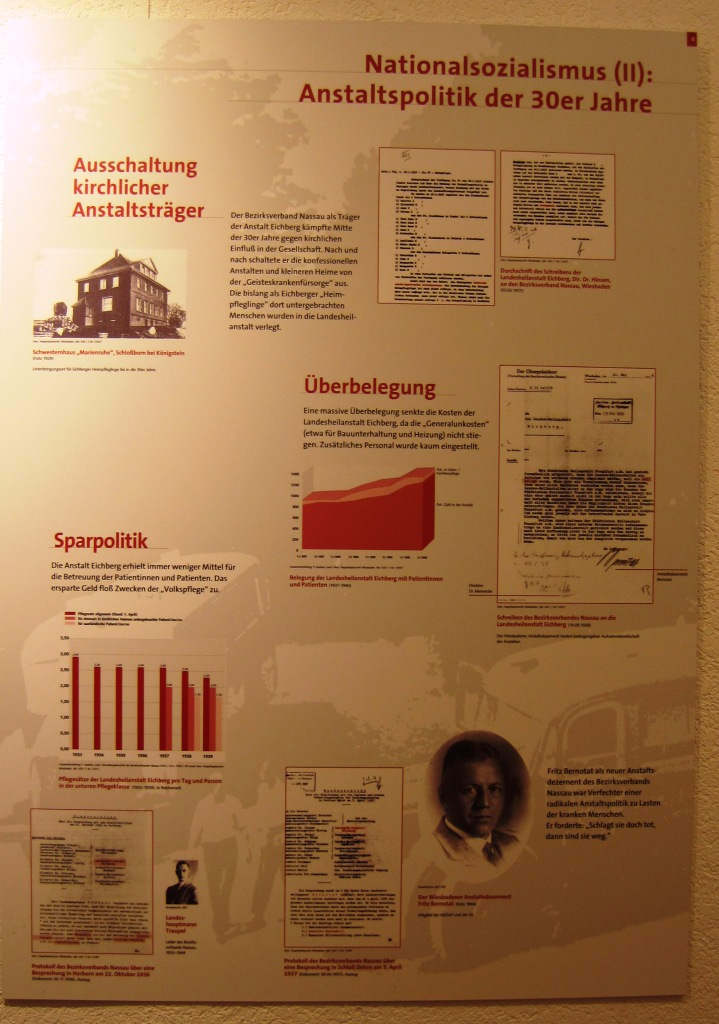
|
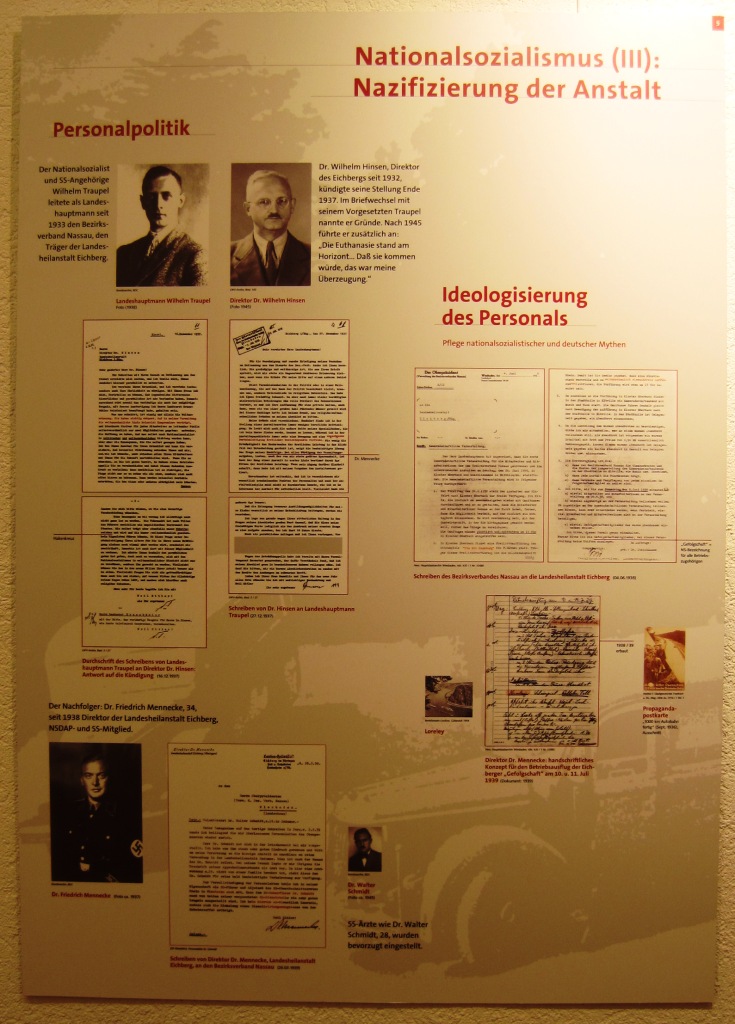
|
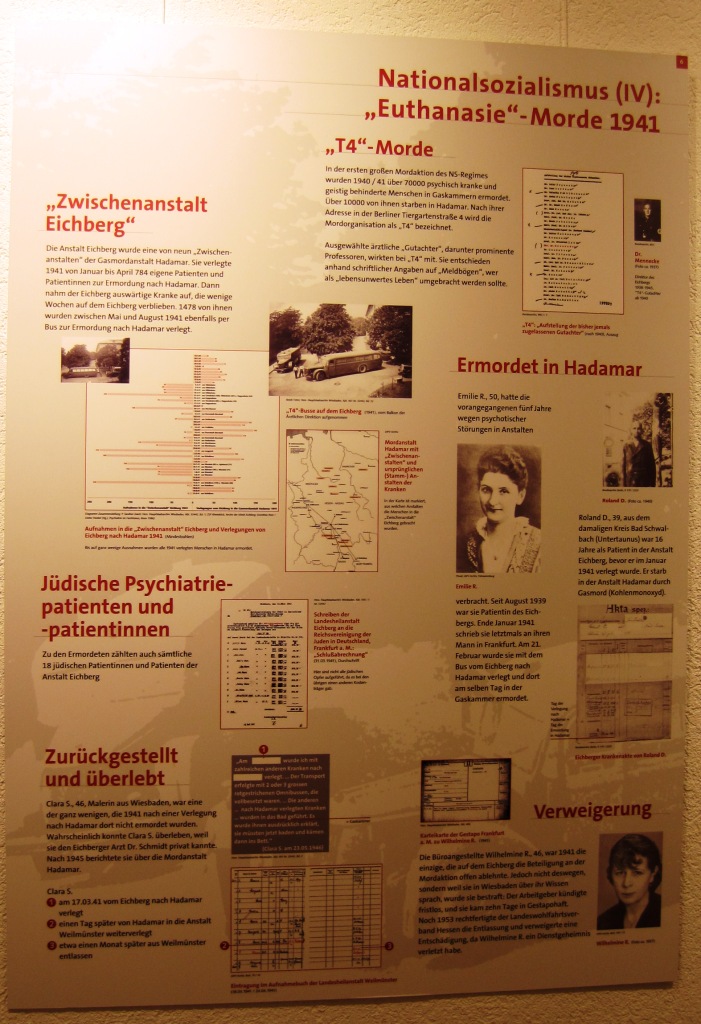
|
Panel 4: "National Socialism (II):
Politics at the institution in the 1930s"
Presents further information about changes in the 1930s: the
elemination of religious oversight, crowding, and reduction of
expenses for caring for the sick and disabled. |
Panel 5: "National Socialism (III):
Nazification of the facility"
Addresses personnel policy and Nazi ideology at the facility using
personal documents
|
Panel 6: "National Socialism (IV):
'Euthanasia' Murders 1941"
Presents an overview of the T4 program, Eichberg's function as a
base as well as an intermediary facility for patients transported to
the T4 gas murder facility Hadamar, the fate of Jewish patients from
Eichberg murdered at Hadamar, a case of a patient who was sent back
from the doorsteps of the gassing facility, two histories of
patients who were gassed, and a rare case, one in which an
Eichbergnurse refused to participate in the murder program.
|
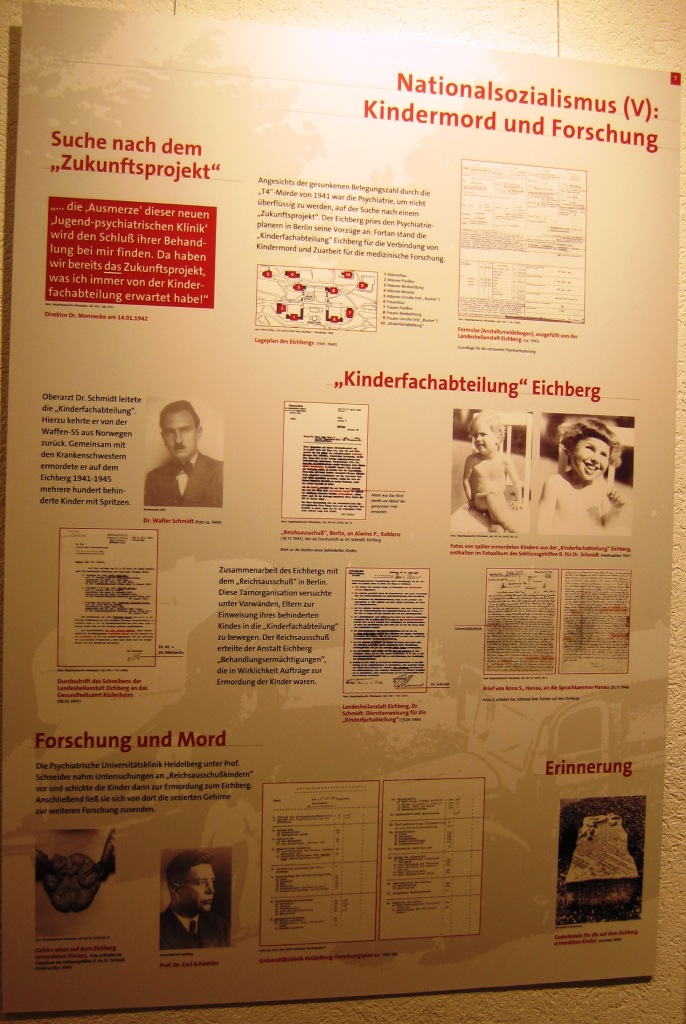
|
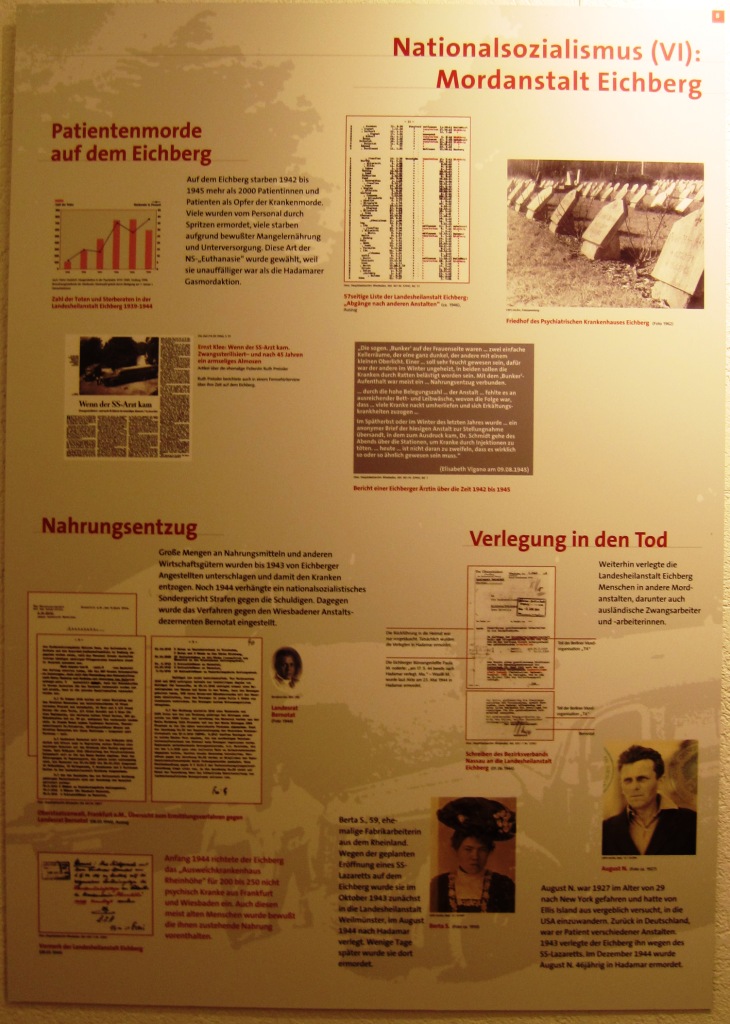
|
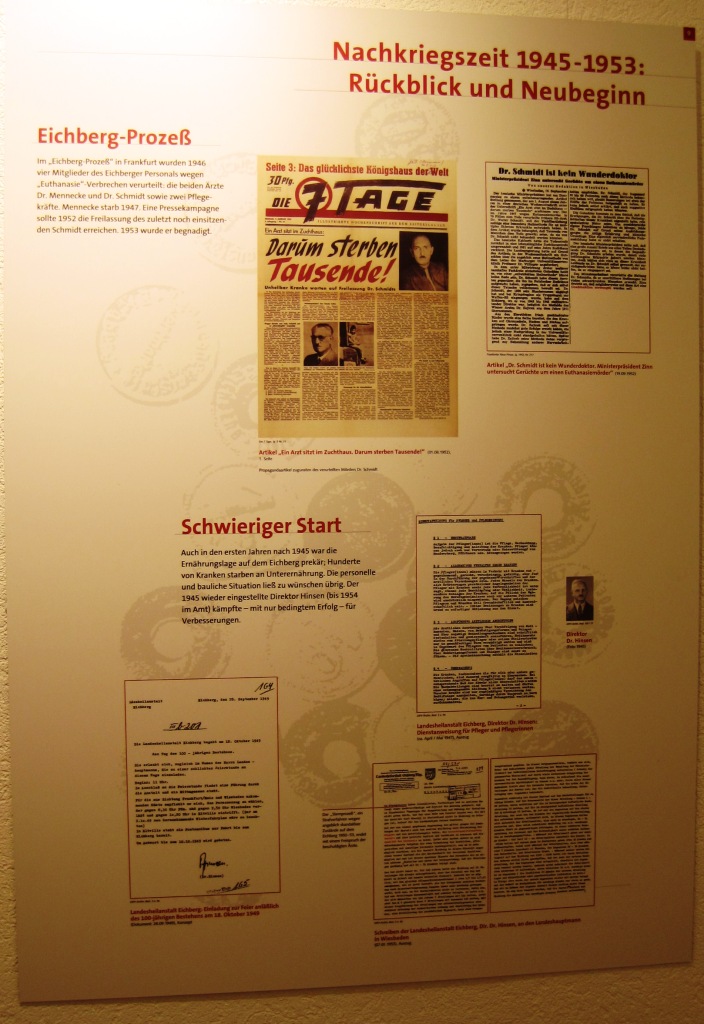
|
Panel 7: "National Socialism (V):
Child murder and research"
States the involvement of the Eichberg facility as a child
"euthanasia" facility: its beginnings, operation, connection to
"research," and commemoration. today
|
Panel 8: "National Socialism (VI):
Murder facility Eichberg"
Relates to the more than 2000 dead patients at the Eichberg, and
death through starvation, as well as the transport of forced
laborers to Hadamar.
|
Panel 9: "Postwar period: 1945=1953:
A look back and a new beginning"
Presents an overview of the trials against core "euthanasia"
perpetrators and advocacy for Dr. Schmidt. Also notes the difficult
financial at the Eichberg after 1945. |
Source: author; Vitos
Rheingau.
Around 2006 a working group Gedenkstätte
(Memorial) formed with the purpose of engaging further with the
history of the Eichberg. On September 1, 2009, on occasion of the 70th
anniversary of Hitler’s “euthanasia” decree, the working group helped
open a new place of encounter in House 8, at the site of two former
“bunkers” where patients were disciplined, with displays that originated
in the 1999 exhibit, and seminar rooms and a library. The exhibit
contextualizes the "euthanasia" crimes at the Eichberg, and one display
provides a detailed account of the historical events (see above). An
annual commemorative event in September is planned. A newspaper report
is provided here. A commemorative event was held on
September 1, 2011, and such an activity is planned to be continued
on that day of the year in future years. A recent public lecture
on the subject matter is addressed in a newspaper article (here), as well as
in another newspaper article that pertains to family members of victims
(here).
A scholarly analysis of the history of commemoration and its determinants by
the author (Kaelber 2011b, 2011c, 2012) can be found here, and in an extended version, here.
Note: there are two important supplementary files: 1 and 2.
The realization of a new memorial installation "how distant and how close"
(mostly) in the cemetery is planned in the near future. As the artist Birgid Helmy
explains, a series of cement blocks organized in a spiral will contain the
names and dates of birth and death of the about 2,500 victims. Individual
blocks can be placed in the various places of memory, but the center will be
in cemetery and feature a round stelae in the center, with a base and a
sculpture of a brain covered by glass. The spiral placement of the blocks is
meant to reflect the structure of the human brain. There will also be a
sculpture of a child on the cemetery, and a stela at the location where the
"T4" busses had arrived.
Child victims who are known by name due to a newspaper story, web page about
their life, or other form of memorialization include a number of children
sent to the Eichberg from the Alsterdorfer Anstalten (list).
Their names include Ursula Bohmann, Grete Detert, Werner Gross, Irmgard
Hrabe, Hugo Stoltze, Lola Ulawski, and Gustav Wagener. There is a
"Stolperstein" for Gerhard Durner (here).
In 2015, a stumbling block was installed in Hamburg for Uwe Hinsch (see here),
who died at the Eichberg in 1943 within 10 days after his transfer from the
Alsterdorfer Anstalten in Hamburg. Another stumbling block was laid there
for Walter Stein, who also had been transferred from there to the Eichberg.
Brief biographical accounts of Walter Stein and Uwe Hinsch can be found in
Barreiro et al. (2014).
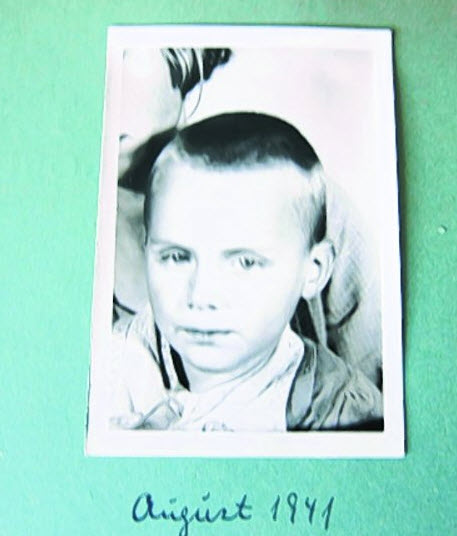 Uwe Hinsch. Source: Elbe Wochenzeitung;
http://www.elbe-wochenblatt.de/harburg/lokales/acht-neue-stolpersteine-d30877.html
Uwe Hinsch. Source: Elbe Wochenzeitung;
http://www.elbe-wochenblatt.de/harburg/lokales/acht-neue-stolpersteine-d30877.html
In addition, there may soon be stumbling blocks for Karl-Heinz D., Clause
H., and Luise S., who also were sent from the Alsterdorfer Anstalten and
died at the Eichberg facility in 1943.
In her book on Esslingen during National Socialism, G. Siberzahn-Jandt
(2015) addresses the fate of children sent from Esslingen to the Eichberg
(pp. 221-22). Based on records of the Grafeneck trial, she refers to Jürgen
Erhard, Günther Markgraf, and Else Weber (pp. 278-79).
Digital reproductions of the Grafeneck trial relate to Margarethe
Michelfelder (http://www.landesarchiv-bw.de/plink/?f=6-902919)
and a series of other children from Wurttemberg who died at the Eichberg
facility (or were admitted; http://www.landesarchiv-bw.de/plink/?f=6-902858).
As of September 2015, the plans for the realization of the new memorial
still appear to be tentative. The artist Birgid Helmy has presented a new
installation, entitled "Kinderfachabteilung," at the Eichberg (see here).
Literature
Amler, Gerhard. ca 1981. Chronik
des psychiatrischen Krankenhauses Eichberg. Unpublished ms.
Barreiro, Alicia, Benita Fussy, Gerrit Liebing, Asli Kaya, Tobias Kohl,
Johanna Lotz, Timea Römer, Jana Schlemm, Janina Schlemm. 2014. "'Im
Kinderheim Eissendorfer Pferdeweg nicht tragbar': Vier Harburger Heimkinder
mit Behinderungen: Ihr Leben und ihr Sterben in der NS-Zeit: Dokumentation
eines Schülerprojekts." Brochure. Hamburg: Immanuel-Kant Gymnasium.
Benzenhöfer, Udo. 2003. "Genese und Struktur der
'NS-Kinder- und Jugendlicheneuthanasie.'" Monatsschrift
für Kinderheilkunde 151: 1012-19.
Dickel, Horst. 1983. "Der Eichberg-Opfer und Täter: 'Lebensunwertes' Leben
in der hessischen psychiatrischen Anstalt, 1935-1945." Geisenheim: n.p.
———. 1988. 'Die sind doch alle
unheilbar': Zwangssterilisation und Tötung der 'Minderwertigen' im
Rheingau, 1934-1945. Frankfurt: Verlag Moritz Diesterweg.
———. 1991. "Alltag in einer Landesheilanstalt
im Nationalsozialismus: Das Beispiel Eichberg." Pp. 105-13 in Euthanasie
in Hadamar, edited by the Landeswohlfahrtsverband Hessen. Kassel: Eigenverlag des Landeswohlfahrtsverbandes Hessen.
Harrison,Sharon. "The boundaries of knowing: Female nurses and ‘medicalised
killing’ at the Landesheil- und Pflegeanstalt Eichberg." University of
Melbourne. Available at at http://www.arts.monash.edu.au/publications/eras/edition-11/articles/sharrison.pdf
Hohendorf, Gerrit, Volker Roelcke, and Maike Rotzoll. 1996. "Innovation
und Vernichtung: Psychiatrische Forschung und 'Euthanasie' an der
Heidelberger Psychiatrischen Klinik, 1939-1945." Nervenarzt
67(11): 936-45.
Hohendorf, Gerrit; and Maike Rotzoll. 2014. "Medical Research and National
Socialist Euthanasia: Carl Schneider and the Heidelberg Research Children
from 1942 to 1945." Pp. 127-38 in Human
Subjects Research after the Holocaust, edited by Sheldon
Rubenfeld and Susan Benedict. New York: Springer.
Kaelber, Lutz. 2011a. “Gedenken an die NS-‘Kindereuthanasie’-Verbrechen in
Deutschland, Österreich, der Tschechischen Republik und Polen.” In Kindermord und “Kinderfachabteilungen” im
Nationalsozialismus: Gedenken und Forschung, edited by Lutz
Kaelber and Raimond Reiter. Hamburg: Peter Lang.
———. 2011b. “Gedenken an die
NS-‘Kindereuthanasie’: Das Fallbeispiel der Landesheilanstalt Eichberg.”
Gedenkstätten-Rundbrief 161: 14-24. Available (without table and pictures)
at <http://www.gedenkstaettenforum.de/nc/gedenkstaetten-rundbrief/rundbrief/news/gedenken_an_die_ns_kindereuthanasie_das_fallbeispiel_der_landesheilanstalt_eichberg/>.
———. 2011c. “Gedenken an die
NS-‘Kindereuthanasie’: Zwei Fallbeispiele und allgemeine Folgerungen zur
Gedenkkultur.” Pp. 201-32 in Den Opfern
ihre Namen geben: NS-“Euthanasie”-Verbrechen, historisch-politische
Verantwortung und Erinnerungskultur, edited by the Arbeitskreis
zur Erforschung der nationalsozialistischen “Euthanasie” und
Zwangssterilisation. Munster: Klemm und Oelschläger, 2011.
———. 2012. "Child
Murder in Nazi Germany: The Memory of Nazi Medical Crimes and
Commemoration of 'Children’s Euthanasia' Victims at Two Facilities
(Eichberg, Kalmenhof)." Societies 2(3) (2012): 157-194.
Available at <http://www.mdpi.com/2075-4698/2/3/157>
and here.
Note: there are two important supplementary files: 1 and 2.
Kreitmair, Markus B. 2000. "In Fear of the Frail: The Treatment of the
Disabled at the Eichberg Asylum for the Mentally Ill in Nazi Germany."
M.A. Thesis, Department of History, Simon Fraser University. Available at
http://www.collectionscanada.gc.ca/obj/s4/f2/dsk2/ftp03/MQ51380.pdf.
Landeswohlfahrtsverband Hessen. 1985. Mensch,
achte
den Menschen: Frühe Texte über die Euthanasieverbrechen der
Nationalsozialisten in Hessen. 3d ed. Kassel: Eigenverlag des
Landeswohlfahrtsverbandes Hessen.
Meusch, Matthias. 1997. "Die Frankfurter 'Euthanasie'-Prozesse 1946-1948:
Zum Versuch einer umfassenden Aufarbeitung der NS-'Euthanasie.'" Hessisches
Jahrbuch für Landesgeschichte 47: 253-86.
Nuhn, Christiane. 1989. "Die psychiatrische Anstalt
Eichberg und ihre Direktoren 1938-1945." Pp. 209-12 in Das
Schicksal
der Medizin im Faschismus, edited by A. Thom and S. M. Rapoport.
Berlin: VEB Verlag Volk und Gesundheit.
Orth, Linda. 1989. Die Transportkinder
aus Bonn: "Kindereuthanasie." Cologne: Rheinland-Verlag (here:
58-69).
Platen-Hallermund, Alice. 1948. Die
Tötung Geisteskranker in Deutschland. Frankfurt: Verlag der
Frankfurter Hefte.
Puvogel, Ulrike, and Martin Stankowski. 1996. Gedenkstätten
für
die Opfer des Nationalsozialismus, vol. 1. 2d ed. Bonn: Bundeszentrale
für politische Bildung. Available at http://www.bpb.de/files/5JOYKJ.pdf.
Sandner, Peter. 2003. Verwaltung des
Krankenmordes: Der Bezirksverband Nassau im Nationalsozialismus.
Gießen: Psychosozial-Verlag. Available here: Anfang
und Kapitel I - Kapitel II - Kapitel III - Kapitel IV - Kapitel V - Schluss und Anhang
Schneider-Wendling, Andrea. 1997. "Anstaltspsychiatrie im
Nationalsozialismus am Beispiel der Heil- und Pflegeanstalt Eichberg." MD.
Diss., Johannes Gutenberg-University Mainz.
Schreeb, Hans D. 2006. "Die Heil- und Pflegeanstalt Eichberg: Todesurteile
bei der abendlichen Visite." Wiesbadener
Tageblatt, June 9.
Silberzahn-Jandt, Gudrun. 2015. Esslingen
am Neckar im System von Zwangssterilisation und "Euthanasie" während des
Nationalsozialismus: Strukturen - Orte - Biographien. Ostfildern:
Jan Thorbecke.
Teich, Sabine, and Anke Tucholski. 1992. "Eine Studie über
'Kindereuthanasie' in der Kinderfachabteilung der LHA Eichberg anhand der
Krankenakten im Hessischen Hauptstaatsarchiv in Wiesbaden." Master's Thesis
in Social Work, Fachhochschule Frankfurt a.M.
Topp, Sascha. 2004. “Der ‘Reichsausschuss zur wissenschaftlichen Erfassung
erb- und anlagebedingter schwerer Leiden’: Zur Organisation der Ermordung
minderjähriger Kranker im Nationalsozialismus 1939-1945.” Pp. 17-54 in Kinder
in der NS-Psychiatrie, edited by Thomas Beddies and Kristina Hübener.
Berlin-Brandenburg: Be.bra Wissenschaft.
———. 2005. "Der 'Reichsausschuß zur wissenschaftlichen
Erfassung erb- und anlagebedingter schwerer Leiden': Die Ermordung
minderjähriger Kranker im Nationalsozialismus 1939-1945." Master's Thesis
in History, University of Berlin.
Vanja, Christina, Steffen Haas, Gabriela Deutschle, Wolfgang
Eirund, and Peter Sandner, eds. 1999. Wissen
und Irren: Psychiatriegeschichte aus zwei Jahrhunderten - Eberbach und
Eichberg. Kassel: Eigenverlag des Landeswohlfahrtsverbandes
Hessen. (Especially the contributions by Sandner, Hohendorf et al., and
Faulstich.)
Last updated on 13 September 2015
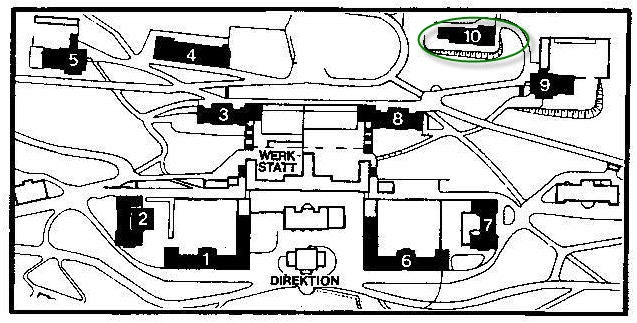
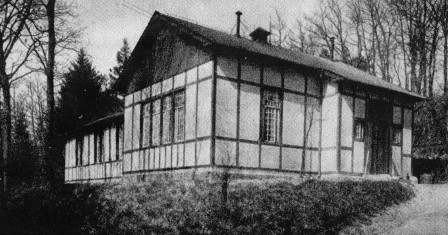



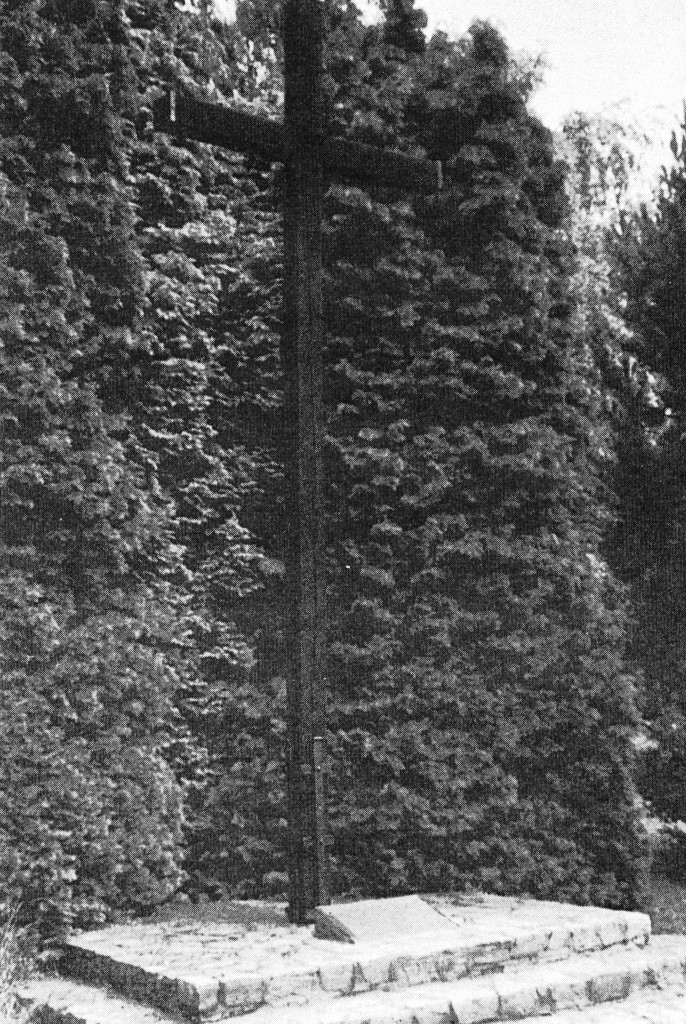
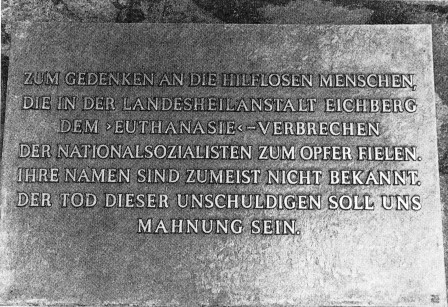

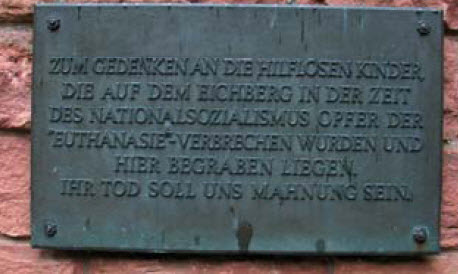
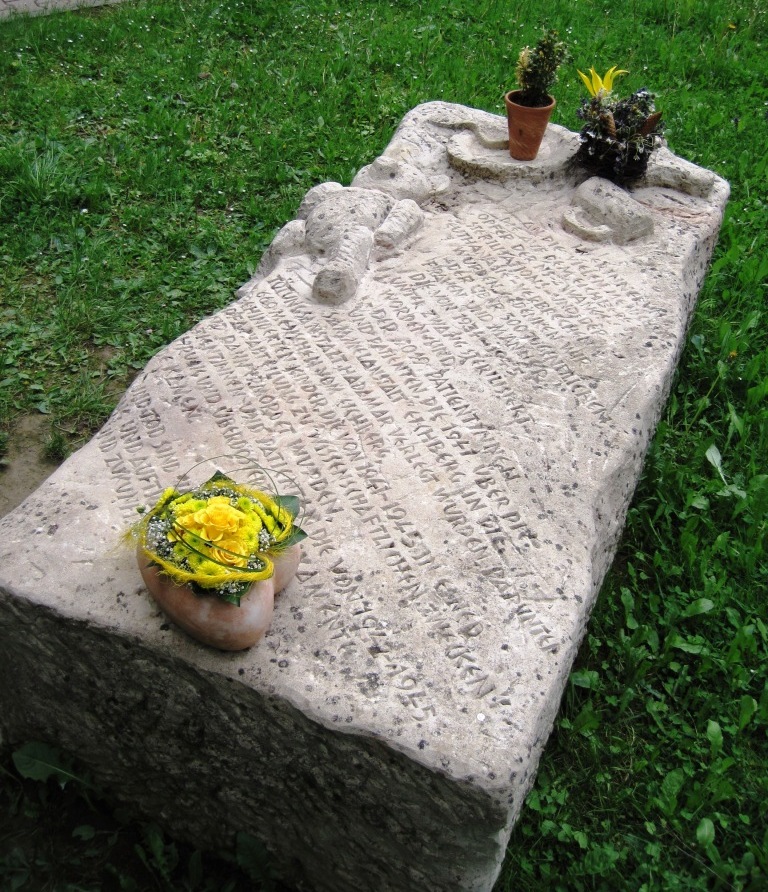










 Uwe Hinsch. Source: Elbe Wochenzeitung;
http://www.elbe-wochenblatt.de/harburg/lokales/acht-neue-stolpersteine-d30877.html
Uwe Hinsch. Source: Elbe Wochenzeitung;
http://www.elbe-wochenblatt.de/harburg/lokales/acht-neue-stolpersteine-d30877.html